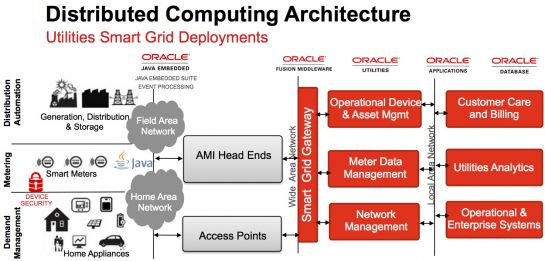The long-promised goal of embedding open, flexible computing power in all types of smart grid devices is starting to be realized in 2014.
Open platforms from Silver Spring Networks, Cisco, Itron and other grid vendors are being introduced. Multi-vendor partnerships driven by utilities like Duke Energy and Toronto Hydro are creating new ways for smart meters, solar PV and battery inverters, distribution grid gear and other equipment to interact on the grid edge.
Open computing platforms like Linux, Android and Java are at the foundations of many of these efforts. Oracle, the database giant with a significant stake in smart grid technology, just happens to own Java developer Sun Microsystems. Embedded Java -- the version designed for mobile or remote computing platforms -- is now part of billions of SIM cards and mobile handsets, millions of TV devices (including every Blu-ray player), and other networked machines from office equipment to cars.
So it makes sense that smart grid devices are next on Oracle’s Embedded Java roadmap. In fact, they’re already out there today, in test beds like San Diego Gas & Electric’s Borrego Springs microgrid project (PDF), a showcase for Oracle’s grid management software to tackle a range of grid edge challenges.
“We’ve built prototypes for Borrego Springs, and demonstrated that,” Brad Williams, vice president at Oracle Utilities, said in an interview last week. “Certainly this is a key investment area for us. The main point is that Oracle embraces these distributed architecture concepts, and supports them through our core applications.”
For Oracle, those core applications range from its customer relations, billing and meter data management software used by a hefty roster of utility customers, to its network management system. That's Oracle’s version of an advanced distribution management system (ADMS), which is the central platform at Borrego Springs.
As for the equipment that’s getting embedded with Java, “we are working with our customers to do that with meters, head-end systems, home area network devices,” said Williams. “But our intent is to take this further into substation automation, switchgear, manufacturers like S&C Electric, Schweitzer Engineering Laboratories,” he said. Oracle has had some initial discussions with them, though it hasn’t announced any official partners yet.
Of course, this work is still in the “visionary” phase, Williams noted -- as are the rest of the distributed intelligence grid projects underway around the world. It takes some convincing to get grid equipment vendors to open up their systems, and even for heavy utility trendsetters like Duke, it’s still being done as an experiment. If those experiments prove fruitful, vendors are going to have to make some important changes to their device hardware, starting from the chipsets on up.
“The way we work with the ecosystem is [we] go back to system-on-a-chip [firms] like Freescale and Qualcomm to increase their portfolio of equipment for Java,” said Simon Nicholson, senior director of product management for Oracle’s Java team. “We also work with the OEMs, the major meter manufacturers.”
Take the example of Oracle’s work in Latin America, where it’s partnering with Dutch data security company Gemalto and Brazilian metering company V2COM to embed Java in smart meters and connect them with its MDM software. Oracle, which owns smart meter data analytics company DataRaker, is working on several distributed applications to run across the strongbox-secured meters that Latin American utilities use to prevent meter tampering, he said. One obvious application is non-technical loss (i.e., theft) detection, Nicholson noted -- “There’s tremendous commercial value there.”
Why the grid edge needs distributed intelligence
As with many other embedded intelligence efforts, one of the key issues Oracle hopes to solve is managing the massive amounts of data being generated by smart devices on the edge of the network, Nicholson said. “If you can start driving decision-making to the edge, or locally, you can enable faster turnarounds,” Nicholson said.
But there’s also the possibility of embedding applications in the devices themselves, he added. “Because the Java at the edge is the same as the Java at the data center, that makes integration from the back end much easier. […] They can potentially move application logic out into the neighborhood,” he said. “We’re already seeing engagements now, and deployments in some cases, where Java is enabling the intelligence platform on the edge.”
In the meantime, safety and security are critical utility concerns. “Particularly when we’re talking about grid operations, utilities cannot have these distributed processes doing things that could create safety concerns," Williams said. That makes back-office applications, like Oracle’s network management system (NMS) in Borrego Springs, the "overarching authority to the distributed intelligence."
“We are the database of record for the real-time model configuration,” he said. “If we dispatch a crew to work on that line, we’ll tag that out, lock that out, and synchronize the devices that are tagged and locked out with distributed processes.” That’s something that the most sophisticated ADMSs are only beginning to take on in field operations.
Security is another part of that local-plus-central coordination. “We want to make sure our devices have the security to authenticate [that the information] is coming from a valid application, a valid location, before it will allow that change to happen.” Open systems are obviously open to intrusion and attack by bad actors, but the history of open standards in the IT world have proven that they end up improving security in the long run -- something that’s gotten lots of attention in the smart grid space lately.
As for which applications utilities are asking for, “the big ones that we know our customers are wanting today are around meter device management, firmware updates, configuration management, those types of things,” he said. “We have the back-office applications that already support that through the proprietary meter head-ends, and we’re working to try to make these more standards based."
This kind of IT threading through whatever proprietary or partly closed, partly open systems utilities have already installed is a challenge. But it’s also critical to make sure the central-control-to-device platform being built can really do what Java allows internet-networked computers to do: open up secure, yet reliable, channels for multiple applications to coexist.

For example, if properly set up, “any of the applications can go do a meter ping, and it’s routed through the actual proper device,” Williams said -- something that’s surprisingly hard to set up using today’s convoluted set of enterprise-to-operations-to-devices IT architectures. More standardization could make smart-meter-based analytics and automation much cheaper and simpler to implement, and help boost the still low number of utilities fully engaged in managing the smart meter data they already have, according to Oracle’s surveys on the topic.
Beyond that, a world of grid edge applications opens up, including the gamut of solar sensing and forecasting, smart inverter communications and control, grid sensor and voltage regulation coordination, and switches and reclosers to keep it all contained within the proper boundaries that it’s testing out in Borrego Springs with SDG&E.
What’s built for a microgrid like that could be applied to many distributed contexts, he added. One very big East Coast utility has asked Oracle for end-to-end visibility, including Embedded Java on each endpoint, for distributed control, he said. “They’ve got to have ways to collect that data and respond to that in real time.”
That fits in with Greentech Media’s concept of the grid edge as a frontier for IT innovation. And it also aligns with the epochal challenge utilities are facing in integrating their millions of new active, co-generating customers into the grid.
“That’s what the utility wants -- they want to be assured they’re in control,” Williams said. “Those are some of the concerns with some of the smart grid technology – and it’s getting further than arms’ length from their control.”
To learn more about innovations in distributed intelligence on the grid, join Greentech Media at the Grid Edge Live conference this June 24-25 in San Diego, Calif.



